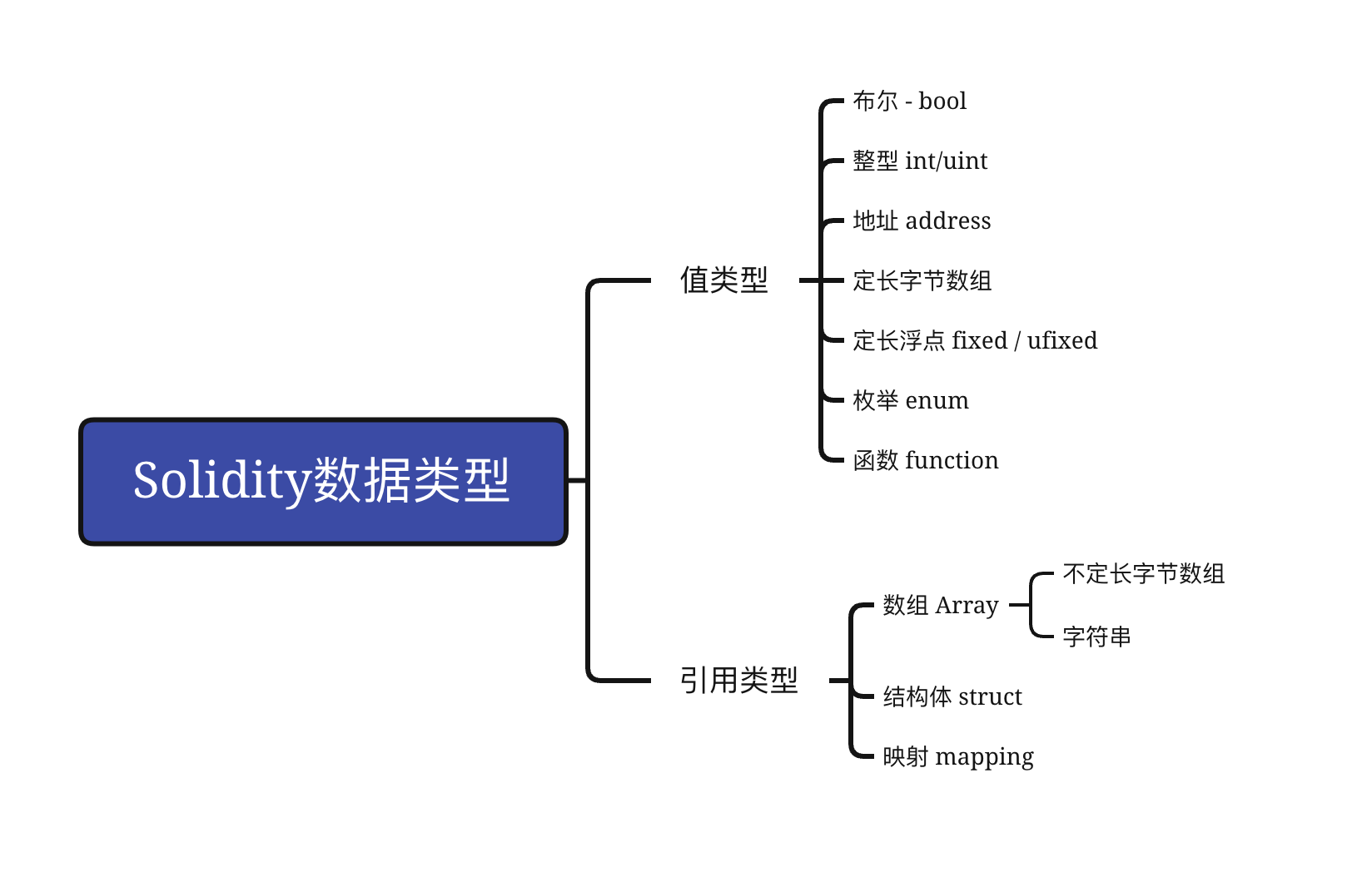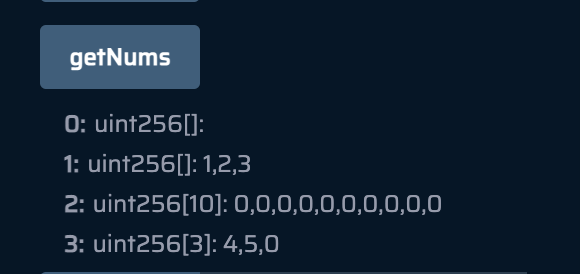Solidity 是一种静态类型语言,这意味着每个变量(状态变量和局部变量)都需要在编译时指定变量的类型。
Solidity 提供了几种基本类型,并且基本类型可以用来组合出复杂类型。

除此之外,类型之间可以在包含运算符号的表达式中进行交互。
“
undefined
”或“
null
”值的概念在Solidity中不存在,但是新声明的变量总是有一个 默认值 ,具体的默认值跟类型相关。 要处理任何意外的值,应该使用错误处理来恢复整个交易,或者返回一个带有第二个
bool
值的元组表示成功。
bool/布尔类型
布尔值的取值范围为 true 和 false 。
默认值:
false
pragma solidity ^0.8.0;
contract TestBool {
error NotEqual(bool A,bool B);
bool public A; // false
bool public B = true; //true
// require(A==B,"A not equal B");
if (A != B) {
error NotEqual(A,B);
}
}运算符:
-
!
(逻辑非) -
&&
(逻辑与, “and” ) -
||
(逻辑或, “or” ) -
==
(等于) -
!=
(不等于)
int、uint/整数类型
int 有符号整型
默认为
int256
不同位长的整形范围如下:
-
int8
取值范围:-(2 ** 7)到 2 ** 7 -1 -
int16
取值范围:-(2 ** 15)到 2 ** 15 -1 - …
-
intX
取值范围:-(2**
X
-1)到 2**(
X
-1) -1 -
int256
取值范围:-(2 ** 255)到 2 ** 255 -1
uint 无符号整型
默认为
uint256
不同位长的整形范围如下:
-
uint8
取值范围:0 到 2 ** 8 – 1 -
uint16
取值范围:0 到 2 ** 16 – 1 - …
-
uintX
取值范围:0 到 2 **
X
– 1 -
uint256
取值范围:0 到 2 ** 256 – 1
运算符:
- 比较运算符: <= , < , == , != , >= , > (返回布尔值)
- 位运算符: & , | , ^ (异或), ~ (位取反)
- 移位运算符: << (左移位) , >> (右移位)
- 算数运算符: + , – , 一元运算负 – (仅针对有符号整型), * , / , % (取余或叫模运算) , ** (幂)
对于整形 X,可以使用 type(X).min 和 type(X).max 去获取这个类型的最小值与最大值。
// SPDX-License-Identifier: MIT
pragma solidity ^0.8.0;
contract TestIntval {
int8 public i8 = -1;
int public i256 = 456;
int public i = -123; // int 等同于 int256
// int 的最大最小值
int public minInt = type(int).min;
int public maxInt = type(int).max;
uint8 public u8 = 1;
uint256 public u256 = 456;
uint public u = 123; // uint 等同于 uint256
// uint 的最大最小值
uint public minUInt = type(uint).min;
uint public maxUInt = type(uint).max;
function mini() public pure returns(uint8){
return type(uint8).max;
}
}
0.8.0 开始,算术运算有两个计算模式:一个是 “wrapping”(截断)模式或称 “unchecked”(不检查)模式,一个是”checked” (检查)模式。 默认情况下,算术运算在 “checked” 模式下,即都会进行溢出检查,如果结果落在取值范围之外,调用会通过 失败异常 回退。 你也可以通过
unchecked { ... }
切换到 “unchecked”模式
// SPDX-License-Identifier: GPL-3.0
pragma solidity ^0.8.0;
contract C {
function f(uint a, uint b) pure public returns (uint) {
// 减法溢出会返回“截断”的结果
unchecked { return a - b; }
}
function g(uint a, uint b) pure public returns (uint) {
// 溢出会抛出异常
return a - b;
}
}

调用
f(2, 3)
将返回
2**256-1,
而
g(2, 3)
会触发失败异常。
unchecked
代码块可以在代码块中的任何位置使用,但不可以替代整个函数代码块,同样不可以嵌套。
此设置仅影响语法上位于
unchecked
块内的语句。 在块中调用的函数不会此影响。
address/地址
默认值: 0x0000000000000000000000000000000000000000
运算符:
- <=, <, ==, !=, >= and >
示例:
// SPDX-License-Identifier: MIT
pragma solidity ^0.8.0;
contract TestAddress {
//与其他机器语言相区别的类型就是这个address 类型,160-bit/20byte
address public myAddr = 0x5B38Da6a701c568545dCfcB03FcB875f56beddC4;
//合约自己的地址
address contractAddress = address(this);
//跟普通的地址类型一样,但多了两个方法 transfer/send 这两个方法后面章节会讲到
// address sender = payable(0x5B38Da6a701c568545dCfcB03FcB875f56beddC4);
//可以使用 balance 属性来查询一个地址的余额
function getBalance()
public view
returns (uint256, uint256)
{
require(myAddr.balance < contractAddress.balance, "1 must lg 2");
return (myAddr.balance, contractAddress.balance);
}
}

bytes/字节数组
在计算机中的最小存储单位是 bit(位)
- 1byte等于8位
- Solidity中,byte可以赋值为
- 16进制数字
- 单引号的单个或多个字符
定长字节数组
bytes1 后面数字1是表示1字节 bytes默认等于bytes1
Bytes2 后面数字2是表示2字节
Bytes3 后面数字3是表示3字节
bytes4 后面数字4是表示4字节
…
bytes32 后面数字32是表示32字节
bytes32 等价于 int256或uint256 的位数
运算符
- 比较运算符: <=, <, ==, !=, >=, > (返回布尔型)
- 位运算符: &, |, ^ (按位异或), ~ (按位取反)
- 移位运算符: << (左移位), >> (右移位)
- 索引访问:如果 x 是 bytesI 类型,那么 x[k] (其中 0 <= k < I)返回第 k 个字节(只读)。
成员变量
.length
表示这个字节数组的长度(只读)
// SPDX-License-Identifier: MIT
pragma solidity ^0.8.0;
contract BytesTest {
//定长字节数组,长度不可变
bytes1 public num1 = 0x12;
// bytes1 public num1 = 0x112; 溢出最大长度,这样会报错
// 也可以写成字符串类型
bytes4 public num2 = "0x12";
//也支持直接写 16 进制
bytes4 public num3 = 0x12121212;
//不足位的补0
bytes32 public num4 = 'abc'; //0x6162630000000000000000000000000000000000000000000000000000000000
function getlength1() public view returns (uint8) {
return num1.length;
}
function getlength2() public view returns (uint8) {
return num2.length;
}
}
string/字符串
// SPDX-License-Identifier: MIT
pragma solidity ^0.8.0;
contract TestString {
string public myString = "hello";
string public myStringUnicl = unicode"你好"; //unicode 编码
string public myStringUnicl2 = unicode"你好😄"; //unicode 编码
// 两个字符串连接用 concat
function strConcat(string memory _a, string memory _b)
public
pure
returns (string memory)
{
return string.concat(_a, _b);
}
// 也可以转成bytes,bytes 和 string 可以互转
function bytesConcat(string memory _a, string memory _b) public pure returns (string memory){
bytes memory _ba = bytes(_a);
bytes memory _bb = bytes(_b);
bytes memory ret = bytes.concat(_ba,_bb);
return string(ret);
}
}
enum/枚举
枚举可以在合约之外声明,也可在合约内声明.
默认取值为第一个元素的值
contract UserState {
// 枚举
//默认值是列表中的第一个元素
enum State {
Online, // 0
Offline, // 1
Unknown // 2
}
Status public status;
function get() public view returns (Status) {
return status;
}
// 通过将uint传递到输入来更新状态
function set(Status _status) public {
status = _status;
}
// 也可以是这样确定属性的更新
function off() public {
status = Status.Offline;
}
// delete 将枚举重置为其第一个值 0
function reset() public {
delete status;
}
}
struct/结构体
您可以通过创建结构来定义自己的类型。
它们用于将相关数据分组在一起。
结构可以在合约之外声明,也可以在另一个合约中导入。
// SPDX-License-Identifier: MIT
pragma solidity ^0.8.0;
contract Structs {
struct Todo {
string text;
bool completed;
}
// 结构体数组
Todo[] public todos;
// 初始化结构的3种方法
function create(string calldata _text) public {
// 1.像函数一样调用它
todos.push(Todo(_text, false));
// 2. 键值对
todos.push(Todo({text: _text, completed: false}));
// 3.初始化一个空结构,然后更新它
Todo memory todo;
todo.text = _text;
todos.push(todo);// completed 没有定义,默认为 false
}
//通过索引获取结构体数组中一个元素,并更新内部的属性
function update(uint _index) public {
Todo storage todo = todos[_index];
todo.completed = !todo.completed;
}
}
mapping/映射
映射是使用语法映射(keyType=>valueType)创建的。
keyType可以是任何内置值类型、字节、字符串或任何约定。
valueType可以是任何类型,包括另一个映射或数组。
映射不可迭代。
// SPDX-License-Identifier: MIT
pragma solidity ^0.8.13;
contract Mapping {
//从地址到uint的映射
mapping(address => uint) public myMap;
function get(address _addr) public view returns (uint) {
//映射始终返回一个值。
//如果从未设置该值,它将返回默认值。
return myMap[_addr];
}
// 更新此地址的值
function set(address _addr, uint _i) public {
myMap[_addr] = _i;
}
function remove(address _addr) public {
//将值重置为默认值
delete myMap[_addr];
}
}
//嵌套 mapping
contract NestedMapping {
//嵌套映射(从地址映射到另一个映射)
mapping(address => mapping(uint => bool)) public nested;
function get(address _addr1, uint _i) public view returns (bool) {
// 可以从嵌套映射中获取值
return nested[_addr1][_i];
}
function set(
address _addr1,
uint _i,
bool _boo
) public {
nested[_addr1][_i] = _boo;
}
// 删除 mapping 的一个元素
function remove(address _addr1, uint _i) public {
delete nested[_addr1][_i];
}
}
array/数组
初始化数组的几种方法
//初始化数组的几种方法
uint256[] public arr;
uint256[] public nums = [1, 2, 3];
//定长数组,所有元素初始化为 0
uint256[10] public myFixedSizeArr;
//未定义初始值的元素默认为 0
uint256[3] public three = [4, 5];
// 直接打印数组列表;
function getNums()
external
view
returns (
uint256[] memory,
uint256[] memory,
uint256[10] memory,
uint256[3] memory
)
{
return (arr, nums, myFixedSizeArr,three);
}

// SPDX-License-Identifier: MIT
pragma solidity ^0.8.0;
contract Array {
//初始化数组的几种方法
uint256[] public arr;
uint256[] public nums = [1, 2, 3];
//定长数组,所有元素初始化为 0
uint256[10] public myFixedSizeArr;
uint256[3] public three = [4, 5, 6];
// 获取数组长度
function getLen() external view returns (uint256) {
return nums.length;
}
//向数组中添加值
function pushIndex(uint256 _x) external {
nums.push(_x);
}
// 这样删除数组不会改变数组长度,被删除的数字索引值会变成 0
function deleteIndex(uint256 _x) external {
delete nums[_x];
}
//不改变数组顺序情况下删除数组
//通过循环删除数组索引 [1,2,3,4] => [1,3,4,4] => [1,3,4]
function removeIndex(uint256 _x) public {
require(_x < nums.length, "out of index");
for (uint256 i = _x; i < nums.length - 1; i++) {
nums[i] = nums[i + 1];
}
nums.pop();
}
// 删除数组会改变元素的顺序,但是节省 gas
//[1,2,3,4]=> [1,4,3,4]=>[1,4,3]
function removeIndex2(uint256 _x) public {
require(_x < nums.length, "out of index");
nums[_x] = nums[nums.length - 1];
nums.pop();
}
//移除数组最后一个元素
function pop() external {
nums.pop();
}
//方法测试
function testRemove() external {
nums = [1, 2, 3, 4];
removeIndex(2);
assert(nums[0] == 1 && nums[1] == 2);
assert(nums[2] == 4);
assert(nums.length == 3);
}
}